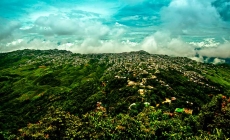-
Rajasthan - November 4, 2015
-
Haryana History - November 1, 2015
-
Haryana - November 1, 2015
-
Mizoram Minerals - March 3, 2015
-
Mizoram Hotels - March 2, 2015
-
Mizoram Culture - March 2, 2015
-
Mizoram Tourist Places - March 2, 2015
-
Mizoram History - March 1, 2015
-
Chhattisgarh Minerals - February 27, 2015
-
Chhattisgarh Hotels - February 27, 2015
Culture in Orissa – The best of Buddhism, Jain, Hindu civilization, and tribal belief have fused to mold the Oriya culture, all theses existed in Orissa in different strength at different period, constantly reacting with each other, borrowing from each other, energizing, developing and synthesizing.
For instance, this evolved in the total deity of Lord Jagannath, an absolute unique god amalgamated from both orthodox and tribal traditions with no trace of caste distinction and untouchability. There are more than 6000 Pandas/Sevaks (helpers) in 36 categories of labor for each, rendering a specified hereditary service to the deity — from flower collecting to garlands to hoisting flag at the top of the temple.
The vegetarian food, Prasad, with more than 64 courses prepared daily at the temple, serving 10,000 (25 during festival times) of visitors from all parts of the world every day, is not just hygienic, healthy, and wholesome but also tasty, representing the authentic Oriya cuisine.
The origin of the God Jagannath, unlike any other divine image in India, is enigmatic. It is evident that he represents a synthesis of Hindu orthodoxy and strong tribal traditions, incorporating some elements of Buddhism and Jainism as well.
Many legends are recounted to explain his strange form. According to the most popular legend, the divine architect Vishwakarma appeared in the guise of an old carpenter and undertook the task of construction of the images on the condition that the doors of the room where he would work would remain closed for a fixed period.
After some days, the queen got nervous and curious and caused the doors to be opened to find that Vishwakarma had disappeared leaving behind three unfinished wooden images, Jagannath, his brother Balarama, and his sister Subhadra. Because the divine images of Jagannath and others are wooden, they are periodically replaced. On a cycle determined by the Hindu calendar, and generally once in 12 years, the deities cast off their old framed and get new ones.
The process of renewal of the body, known as Nava Kalevara (new embodiment), is one of the greatest secrets of the world. It is performed by the senior and distinguished temple priests, each of whom knows only his part of the ritual.
The process includes selection and felling of the Nim tree, carving and painting of the new images, and transferal of the divine essence from the old to the new frame. The latter critical activity reaches its culmination when an unknown ‘divine substance’ is transferred from the chest cavity of the old image to that of the new.
This final, crucial step is performed in the dead of night by the senior most priests, working with eyes blindfolded and hands covered with cloth.
The history of the Jagannath Temple liturgical rituals reveals the variety and splendor of Jagannath -Dharma, the profundity of its theological thought as well as their deep impact on culture and society of Orissa.
Its syncretism of all divergent forms of Indian metaphysical thought and spiritual faculties tend to transcend it to sanatana (ancient) proportions — the cumulative result of fervent and indulgent dispensations of all segments of Indian spiritual tradition.
Further, Jagannath Dharma (loosely religion, conscience, duty and heritage) is soaked in Santana, humanism, i.e., neither materialistic nor spiritualistic but compatible with both. It neither dehumanizes nor sublimates its followers to a state of spirits.
The Jagannath culture has been a balancing act, always striking a balance between freedom and creativity on one hand and discipline and restraint on the other. The Jagannath culture always takes a positive view of life. It does not admit the pessimistic thoughts of grief, suffering and death.
It recommends staunch faith in the Divine. It teaches mankind to strive for the perfection of their soul by the sacrifice of their soul. Material pursuits find no place in the culture. Here, a devotee does not ask for anything material. He or She prays for Divine love.
Lord Jagannath is the ocean of mercy (much prior to Christ’s birth). By his benediction, He can liberate us out of our mortal existence to the Divine Abode. Unflinching faith in the Lord will kill all mundane desires and elevate the human soul. The Jagannath culture teaches us that faith in the Lord and selfless service in the world will usher salvation to mankind.
The martial arts of Orissa originating from the Akhanda tradition of Puri for the defense of the pride and heritage of Orissa, the worlds famous Odissi dance and music coming out of temple tradition, the open-air theater of discourses known as Mukta Mandap, etc., are but a few illustrious example of the former.
While this freedom has been a personal necessity, the discipline has been a social compulsion. Examples galore of the first invocation of Jagannath in each and every auspicious ceremony in the family — whether religious, social, personal or political are found plenty. Every Oriya household grows up under the influence of Jagannath — in rituals, almanac, traditions, and culture irrespective of their secular or ecclesiastical contours.
Language of Orissa : Oriya, one of the oldest languages in the country, is the predominant language spoken in the state and its outlying tracts. Oriya is the official language of the state and 84 per cent of the people speak in Oriya. Besides Hindi, Urdu, Bengali and Telugu are widely understood and sometimes spoken. English is spoken by the educated few.
References:
http://www.indianexcursion.net/orissa/culture-of-orissa.html



















